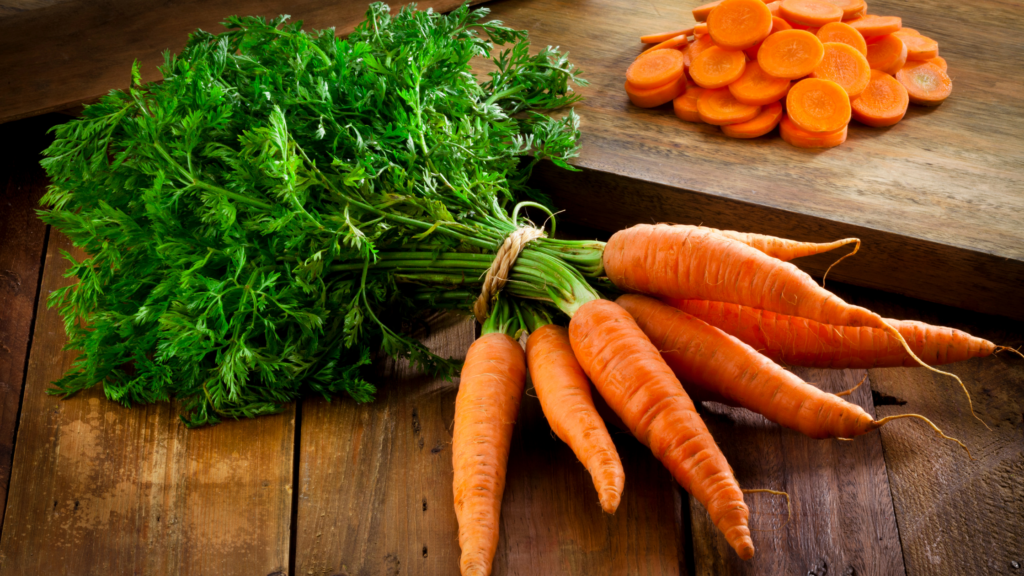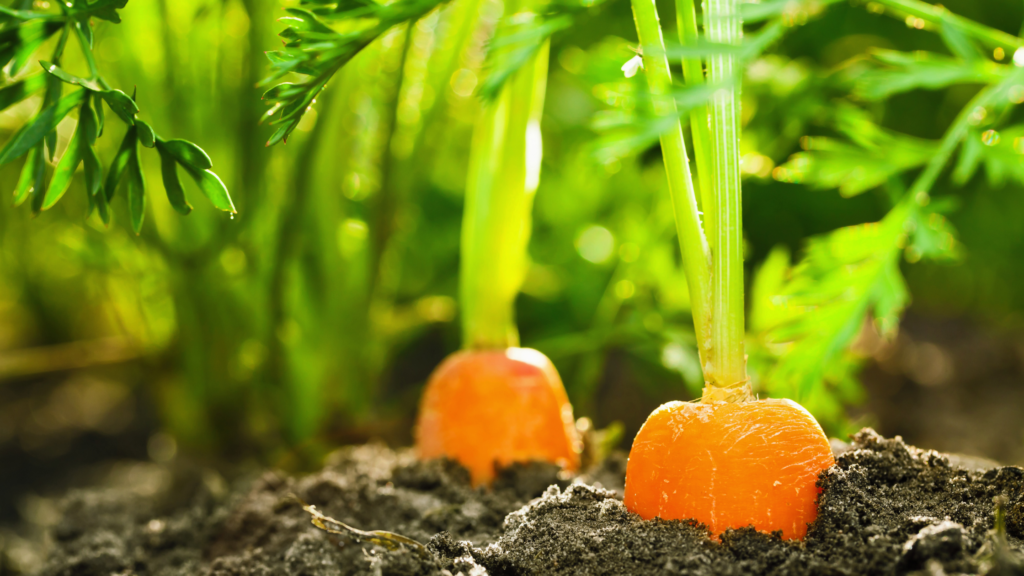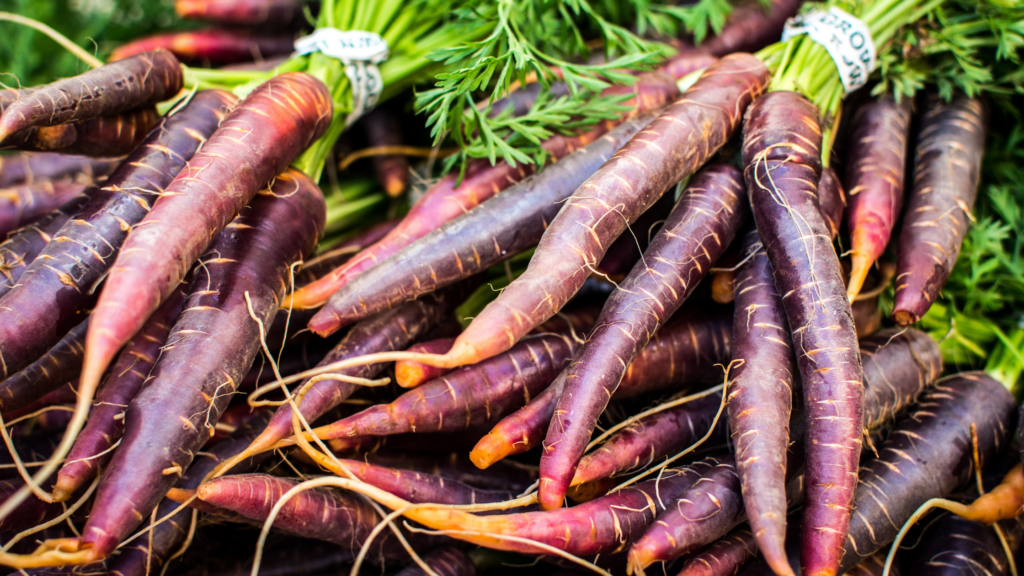Carrots are simple to cultivate and are ready for harvest at any point in their life cycle. To avoid picking them too early or too late, it’s crucial to know when they are ready to be harvested. Read on to find out about the right time carrots ready to harvest.

It is quite disheartening to bring out your carrots after months of diligent weeding and care only to discover little, immature veggies that taste like soap. A flawless carrot may be broken when you attempt to pluck it out of the ground, which is much worse.
The easiest approach to determine when carrots are unquestionably ready for picking is to wait and observe. But truly, there is no quick fix for this problem. The kind of carrot you are growing and the quality of the soil will determine this.
However, generally speaking, homegrown carrots are ready to be picked when the carrots’ shoulders start to stick out of the soil and have grown similarly to a quarter’s size.
Plant your carrot seeds early in the spring for a harvest in the summer, and plant them not later than the middle of August for a harvest in the fall.
If you’ve never grown carrots before or are unsure of how to harvest them or when they are ready to be pulled, keep reading, and you’ll be an expert at timing your harvest!
How Long Does a Carrot Take to Grow?

Carrots are great because you can grow them for almost the whole year. You can plant carrot seeds in succession from early spring to early fall to get a harvest all year long. Just keep in mind that any carrots you sow in the autumn will be needing to be kept alive through the winter and harvested in the spring.
It takes about two to three weeks for seeds to sprout. However, a cold spring or colder fall may make this take even longer. When the seedlings have grown to about one to two inches tall, you’ll need to thin them so that there aren’t too many carrot plants growing in the same space.
Carrots usually will be fully grown after about 60 up to 75 days. But it could definitely be sooner or even later, depending on the type. You may check your seed packet to know the number of days until carrot maturity.
Below are some common carrot varieties and when they are ready to be picked.
| Variety of Carrot | Harvest Time if Planted in Spring | Harvest Time if Planted in Summer |
| Bolero | June to August | September to November |
| Danvers | June to August | September to November |
| Nectar | May to July | August to October |
| Mokum | May to July | August to October |
| Rainbow | May to July | August to October |
| Adelaide | April to June | July to September |
It’s vital to remember that although you may plant carrots in the autumn, you must do so at least 49 days or 12 weeks before the beginning of frost. This will give the plants enough time to grow. You may pick carrots at any time throughout the winter and in the early spring if you decide to overwinter them.
RELATED: Lean, Mean, and Dark Green: 15 Different Types Of Dark Green Veggies
How Can You Tell When Your Carrots Are Ready For Harvesting?
The days to maturity will give you a good idea of when to harvest each kind of carrot, but this will only provide you with an approximation of when the carrots in your specific garden will be ready.
To tell when your carrots are ready to be harvested, use the easy procedures and visual indicators listed below:
- Check the color of the carrot
The hue of the fresh carrots is the greatest indicator of when they are ready to be harvested. When a carrot reaches its full color, it is sweetest and tastes the nicest.
Depending on the kind of carrot you are growing, this will often be a vivid orange color, but it may also be yellow, white, or purple.
- Check the root’s size
The size of the root is another reliable sign of the maturity of a carrot, but mature root size substantially varies by variety.
For widely planted varieties, a lot of gardeners wait until the carrot’s top end is around 1 cm, or half an inch, in diameter before harvesting it.
This is often quite easy to measure since the top part of the carrot, also known as the carrot shoulders, will rise up above the ground.
If the root is still buried underneath, you may create a tiny depression in the soil with your finger to expose the shoulder.
- Try a small bite
The tasting test is the most reliable technique to determine whether your carrots have already produced their greatest flavor. Pull one up and taste it to determine if your carrots are ripe or whether they still need one or two weeks in the ground.
When Is The Best Time Of Year To Harvest Carrots?

Carrots may be gathered at any time of the year and will still be sweet and tasty, even though they taste best when they are fully grown and vibrantly colored. Since carrots are highly cold-hardy, you have a few choices for when to begin digging them up.
1. Summer
Carrots planted in the early spring will be available to harvest as baby carrots in the summer. As soon as your carrots are already sufficiently large to eat, choose this as a delectable summer treat.
During the summer, you may harvest a number of your young carrots and let the remaining carrots to grow until the autumn.
To avoid disturbing the baby carrots you will be leaving behind, take care while removing the young ones. The same can be true if you successively plant or cultivate cultivars with various maturation timeframes.
2. Fall
The optimum harvest time for carrots is often in the fall since the mild nights prevent the carrots from consuming any sugar.
If you keep your carrots in your garden, they will become much sweeter after a few frosts. Carrots turn stored starch in the root into sugar via a process known as chill sweetening to make them very sweet.
3. Winter
Carrots may typically be kept in the soil for all winter time since they are so cold-resistant, and continue becoming sweeter.
Just ensure that the soil doesn’t freeze completely. If you are in a location where ground freezes over, dig carrots after first snowfall.
You may easily pull a small number of carrots out of your garden whenever you want freshly-picked ingredients for dinner over the winter using this method, if your environment permits it. For a little more protection, a lot of gardeners living in colder climes wrap their carrots using straw.
Carrots should be harvested before the weather warms up during spring time, if you decide to leave them in the ground during the winter.
Carrot greens will begin to develop once again when the temperature warms, using sugar found in the root to begin making seeds and leaves. Although it is simple to do so, the edible root will not be able to be saved.
How To Harvest Your Carrots
You may begin to dig as soon as you decide when you will be harvesting your carrots. Although picking carrots is actually pretty simple, following these helpful instructions will help it go as easily as possible.
- Check the carrot size
Examine the size and color of your carrots to determine if they are ready. Keep in mind that just though the leaves are enormous, the carrot may not be ready for harvest.
- Water before you harvest
It might be helpful to give your carrots a gentle watering at least a day before you want to harvest them. Alternatively, you might wait until after a rainy day. This will guarantee that the roots are hydrated before harvest.
However, having excessive water may also be a hassle since muddy soil makes it difficult to pull out your carrots. Ensure that the soil is moist enough but not excessively damp for a simple harvest.
- Loosen compact soil
Have you attempted to pick a carrot out of the ground when it broke off in pieces? It’s crucial to loose soil before plucking to lessen the disappointing dissatisfaction.
For this phase, your garden fork is your best companion, but you may also use a shovel or any gardening instrument of your choice.
Place a garden fork next to your carrots in the ground. Ensure you are sufficiently far to avoid spearing the roots and damaging them. Then pull the dirt and carrots up by tipping your fork backward and away from your vegetables.
- Remove the carrots by pulling them out
You should be able to remove your carrots without worrying about them breaking since you have already loosened up the soil. Pull on the carrots while holding them near the base of the leaves.
The majority of your carrots should easily come out, but if some are still resistant, you may soften the dirt a little bit further.
- Get ready for storage
Remove any additional dirt by sweeping it off the carrot. Do not immediately wash your carrots if you are not going to consume them straight away.
Holding the greens firmly in your hands, twist the leaves off. Cutting off the tops of the carrots as soon as possible is essential; otherwise, any green that is left will rapidly decay and ruin your crop.
The flavor, quality, and shelf life of the root will decrease if the tops are left on because they will drain moisture and the sugar out of the root.
How To Properly Store Your Freshly-Picked Carrots
The ideal temperature to store carrots is 0°C (32°F) and the ideal humidity is 95% . A root cellar, garage, or basement with these environmental conditions will suffice.
As soon as your carrot crop comes out of the ground, and if you don’t use it all up right once, you should start storing carrots for the winter. Here are some guidelines for carrot storage that are safe.
To store the unwashed carrots for a little period of time, put them in a Ziplock bag and keep them in your refrigerator. They may be kept in this way for perhaps a month or two.
They may be kept for four to six months in a wood box that has been filled with moist sand for long-term storage. In addition, carrots may be preserved, pickled, or frozen.
What Can You Do With Bolted Carrots?

Since carrots are biannual, their whole life cycle takes two years to be completed. It is very unusual for carrots to bolt before harvest since their life cycles are so extensive.
However, here are some things you can do with your carrots if they do blossom.
1. Save the seeds
By assuring you will have a seed supply for the next year, seed saving is an excellent method to save money. When they bolt, carrots produce a long stem that grows to a white bloom at the tip. The seeds are located in these blooms.
You may shake out carrot seeds and save them to use for the succeeding season by drying the flower heads.
Just ensure you will only store seeds from heritage carrots and not those hybrid ones, since the latter may not produce plants that are faithful to the original kind.
2. Eat bolted carrots
Although eating bolted carrots is legally OK, you’ll probably discover that they don’t taste very nice. These bolted carrots will be very harsh and woody. The carrot will be far less sweeter than you may be accustomed to because the sugars have been removed.
However, this does not imply that your plants are hopeless. The blooms and leaves are still entirely edible. Just be careful to taste your greens to check for any potential bitterness.
You may eat carrot blossoms raw or include them into your preferred salad since they are quite tasty. Carrot blossoms are not harmful, despite what you may have read or heard elsewhere.
RELATED: Tan Deliciouso! 39 Different Types Of Mexican Vegetables
Frequently Asked Questions
Why are my young carrots taste like soap?
Terpenoids are the answer. Terpenoids, which give foods their “carroty” flavor, have a bitter, soapy flavor. Your carrots are probably undeveloped because carrots create terpenoids before they make sugar.
Can carrots be picked earlier?
Contrary to popular belief, it is preferable to select carrots a bit earlier than when they are large and plump. When chosen as baby carrots, several types are quite tasty, and some of them may be harvested in as little as a month.
The carrot is still edible even if the flavor is not at its greatest if it is picked too early and the terpenoids are too strong.
What will happen if carrots are left in the ground too long?
After a few fall frosts, a process known as chill sweetening actually makes your carrots sweeter, so it could sometimes be advantageous to leave them underneath the ground a little longer. Just protect your late summer or fall carrots from frost by covering them with shredded leaves or even mulch.
Some early carrot root varieties may develop wood and hairs if they are left in the ground for an excessively long time, but they will still be edible.
Mature carrots may be kept in the ground all winter long since they are biennial plants, and they will blossom the following year. Nevertheless, they are no longer particularly edible.
Can carrots be left in the ground over the winter?
Carrots may be left in the ground all winter long in many areas, but you should harvest them if the ground is likely to completely freeze or before they begin to grow again in the spring.
Make sure you sow them in time for winter to prevent them from overmaturing.
Do cooked carrots taste sweeter?
In general, yes. Carrot cooking causes the cell walls to collapse and releases sugar that has been trapped within. Cooking carrots may alter the carrot’s other components as well.
For instance, terpenoids undergo modification during cooking, which explains why cooked bitter carrots often lose their bitterness.
Final Thoughts
Don’t be intimidated by carrot harvesting. You can be sure you’ll get it properly as long as you know what to look for.
Make sure the shoulders are the right size by keeping an eye on them, and don’t be afraid to dig one up sometimes to check on how they’re doing.
It is true that the toughest aspect of growing carrots is being patient. They take some time to fully mature, but the wait is definitely worth it.
Editor’s Recommendations
Once In A Blue Moon: Types Of Blue Colored Veggies







